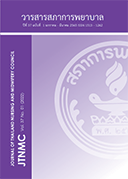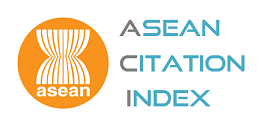ปัจจัยทำนายระยะเวลาการรับบริการในผู้ป่วยสูงอายุที่แผนกฉุกเฉิน
คำสำคัญ:
ผู้ป่วยสูงอายุ, ภาวะโรคร่วม, ความแออัด, การคัดแยกผู้ป่วย, ระยะเวลาการรับบริการที่แผนกฉุกเฉินบทคัดย่อ
วัตถุประสงค์การวิจัย: เพื่อศึกษาอำนาจการทำนายของเพศ อายุ ภาวะโรคร่วม สิทธิการรักษา ระดับความรุนแรงของภาวะฉุกเฉิน ช่วงเวลาปฏิบัติงานที่เข้ารับบริการ ความแออัด สถานะการจำหน่าย ออกจากแผนกฉุกเฉินต่อระยะเวลาการรับบริการในผู้ป่วยสูงอายุที่แผนกฉุกเฉิน
การออกแบบการวิจัย: การวิจัยความสัมพันธ์เชิงทำนาย
การดำเนินการวิจัย: ผู้วิจัยคัดเลือกกลุ่มตัวอย่างเป็นผู้ป่วยสูงอายุที่เข้าเกณฑ์จำนวน 113 คน ที่มีอายุตั้งแต่ 60 ปีขึ้นไป และเจ็บป่วยฉุกเฉินที่ไม่ได้เกิดจากอุบัติเหตุมีระดับความรุนแรงของภาวะฉุกเฉิน ระดับที่ 2-4 ที่เข้ารับบริการแผนกฉุกเฉิน โรงพยาบาลตติยภูมิขนาดใหญ่ เขตกรุงเทพมหานคร เก็บรวบรวม ข้อมูลตั้งแต่เดือนมกราคม – เมษายน 2564 เครื่องมือในการเก็บรวบรวมข้อมูลประกอบด้วย แบบบันทึกข้อมูลส่วนบุคคล และข้อมูลทางคลินิก แบบประเมินภาวะโรคร่วมของชาร์ลสัน แบบประเมินความแออัดดัชนีเอ็ดวิน แบบบันทึกการคัดแยกดัชนีความรุนแรงฉุกเฉิน ฉบับที่ 4 และแบบบันทึกระยะเวลาการรับบริการที่แผนกฉุกเฉิน วิเคราะห์ข้อมูลด้วยสถิติพรรณนา และการวิเคราะห์ถดถอยโลจิสติคทวิ
ผลการวิจัย: กลุ่มตัวอย่างผู้ป่วยสูงอายุ ส่วนใหญ่เป็นเพศหญิงร้อยละ 55.8 อายุเฉลี่ย 72.83 ปี (SD = 9.12) และมีระยะเวลาการรับบริการที่แผนกฉุกเฉินเฉลี่ย 17 ชั่วโมง 18 นาที โดยมีระยะเวลาการรับบริการมากกว่าหรือเท่ากับ 4 ชั่วโมง ร้อยละ 77 โดยเพศชาย ภาวะโรคร่วม การเข้ารับบริการช่วงเวลาปฏิบัติงานเวรดึก และการรับไว้รักษาในโรงพยาบาล สามารถทำนายการมีระยะเวลารับบริการที่แผนกฉุกเฉินมากกว่าหรือเท่ากับ 4 ชั่วโมงด้วยความแปรปรวนร้อยละ 33.5 (Nagelkerke R2 = 0.335) เพศชาย ภาวะโรคร่วม การเข้ารับบริการช่วงเวลาปฏิบัติงานเวรดึก และการรับไว้รักษาในโรงพยาบาล มีโอกาส
ที่จะมีระยะเวลารับบริการที่แผนกฉุกเฉินมากกว่าหรือเท่ากับ 4 ชั่วโมง 3.183, 1.490, 0.169, และ 8.664 เท่า ตามลำดับ
ข้อเสนอแนะ: ผลการศึกษาใช้เป็นข้อมูลสนับสนุนในการดูแลผู้ป่วยสูงอายุ โดยพยาบาลควรให้ความสำคัญกับผู้ป่วยสูงอายุเพศชายที่ได้รับไว้รักษาในโรงพยาบาล และมีภาวะโรคร่วม เพื่อให้ได้รับการดูแลรักษาพยาบาลอย่างรวดเร็ว และลดระยะเวลาการรับบริการที่แผนกฉุกเฉิน
Downloads
References
Samaras N, Chevalley H, Samaras D, Gold G. Older patients in the emergency department: a review. Ann Emerg Med. 2010;56(3):261-9. doi: 10.1016/j.annemergmed.2010.04.015.
Ashman JJ, Schappert SM, Santo L. Emergency department visits among adults aged 60 and over: United States, 2014-2017. NCHS data brief. 2020(367):1-8
Somton A. Annual report 2019-2020. National Institute for Emergency Medicine. [cited 2020 June 4]. Available from: https://ws.niems.go.th/ITEMS_DWH/.
Gilboy N, Tanabe P, Travers D, Rosenau AM. Emergency Severity Index (ESI): a triage tool for emergency department care, Version 4. Implementation Handbook 2012 Edition: Rockville, MD: Agency for Healthcare Research and Quality; 2011. [cited 2020 August 1] Available from: https://www.ahrq.gov/ sites/default/fles/wysiwyg/ professionals/systems/hospital/esi/esihandbk.pdf.
Street M, Mohebbi M, Berry D, Cross A, Considine J. Influences on emergency department length of stay for older people. Eur J Emerg Med. 2018;25(4):242-9. doi: 10.1097/MEJ.0000000000000452.
Sweeny A, Keijzers G, O’Dwyer J, Arendts G, Crilly J. Predictors of a long length of stay in the emergency department for older people. Intern Med J. 2020; 50(5):572-81. doi: 10.1111/imj.14441.
Arendts G, Lowthian J. Demography is destiny: an agenda for geriatric emergency medicine in Australasia. Emerg Med Australas. 2013;25(3):271-8. doi: 10.1111/1742-6723.12073.
Perdahl T, Axelsson S, Svensson P, Djärv T. Patient and organizational characteristics predict a long length of stay in the emergency department - a Swedish cohort study. Eur J Trauma Emerg Surg. 2017;24(4):284-9. doi: 10.1097/mej.0000000000000352.
Ackroyd-Stolarz S, Read Guernsey J, Mackinnon NJ, Kovacs G. The association between a prolonged stay in the emergency department and adverse events in older patients admitted to hospital: a retrospective cohort study. BMJ Qual Saf. 2011;20(7):564-9. doi: 10.1136/bmjqs.2009.034926
Bashkin O, Caspi S, Haligoa R, Mizrahi S, Stalnikowicz R. Organizational factors affecting length of stay in the emergency department: initial observational study. Isr J Health Policy Res. 2015;4:38. doi: 10.1186/s13584-015-0035-6
Latham LP, Ackroyd-Stolarz S. Emergency department utilization by older adults: a descriptive study. Can Geriatr J. 2014;17(4):118-125. doi: 10.5770/cgj. 17.108.
Sullivan C, Staib A, Khanna S, Good NM, Boyle J, Cattell R, et al. The National Emergency Access Target (NEAT) and the 4-hour rule: time to review the target. Med J Aust. 2016;204(9):354-9. doi: 10.5694/mja15.01177
Ministry of Public Health. Indicator details Ministry of Health 2019-2020. [cited 2020 August 1].Available from: https://bps.moph.go.th/new_bps/sites/default/fles/template62_edit3.pdf.
Ye L, Zhou G, He X, Shen W, Gan J, Zhang M. Prolonged length of stay in the emergency department in high-acuity patients at a Chinese tertiary hospital. Emerg Med Australas. 2012;24(6):634-40. doi:110.1111/j.1742-6723.2012.01588.
Hosseininejad SM, Aminiahidashti H, Pashaei SM, Goli Khatir I, Montazer SH, Bozorgi F, et al. Determinants of prolonged length of stay in the emergency department; a cross-sectional study. Emerg (Tehran). 2017;5(1): e53.
Wibulpolprasert A, Sittichanbuncha Y, Sricharoen P, Borwornsrisuk S, Sawanyawisuth K. Factors associated with overcrowded emergency rooms in Thailand: a medical school setting. Emerg Med Int. 2014; 2014:576259. doi: 10.1155/2014/576259.
Lenghong K. Factors affecting length of stay more than 4 hours in the emergency department of Srinagarind Hospital. Srinagarind Medical Journal. 2014;29(1): 7-13. (in Thai)
Sir Ö, Hesselink G, Van Den Bogaert M, Akkermans RP, Schoon Y. Risk Factors for prolonged length of stay of older patients in an academic emergency department: a retrospective cohort study. Emerg Med Int. 2019; 2019:4937827. doi: 10.1155/2019/4937827.
Goluke N, Huibers CJA, Stalpers SC, Taekema DG, Vermeer SE, Jansen PAF. An observational, retrospective study of the length of stay, and its influencing factors, among elderly patients at the Emeof rgency Department. Eur Geriatr Med. 2015;6:331-5. doi: 10.1002/ams2.403.e
Jiamprasert S, Hurst C, Sriprajittichai P. Factors associated with length of stay of non-trauma patients in the Emergency department: a cross-sectional study in Thai healthcare setting. Journal of Medical Association of Thailand 2017;100:1232. (in Thai)
Donabedian A. Evaluating the quality of medical care. Milbank Q. 2005;83(4):691-729.
Casalino E, Wargon M, Peroziello A, Choquet C, Leroy C, Beaune S, et al. Predictive factors for longer length of stay in an emergency department: a prospective multicentre study evaluating the impact of age, patient’s clinical acuity and complexity, and care pathways. Emerg Med J. 2014;31(5):361-8. doi: 10.1136/emermed-2012-155.
Dadashzadeh A, Abdollahzadeh F, Vahdati SS, Lotf M, Ghojazadeh M, Mehmandousti SB. Causes of delay in patient triage in the emergency departments of Tabriz hospitals. Turk J Emerg Med. 2011;11(3):95-8. doi: 10.5505/1304.7361.2011.59354.
Plichta SB, Kelvin EA. Munro’s statistical methods for health care research. 6th ed. Philadelphia: Lippincott Williams & Wilkins; 2013.
Charlson ME, Charlson RE, Peterson JC, Marinopoulos SS, Briggs WM, Hollenberg JP. The Charlson comorbidity index is adapted to predict costs of chronic disease in primary care patients. J Clin Epidemiol. 2008; 61(12):1234-40.
Bernstein SL, Verghese V, Leung W, Lunney AT, Perez I. Development and validation of a new index to measure emergency department crowding. Acad Emerg Med. 2003;10(9):938-42. doi: 10.1111/ j.1553-2712.2003.tb00647.
Sinapidis D, Kosmas V, Vittoros V, Koutelidakis IM,Pantazi A, Stefos A, et al. Progression into sepsis: an individualized process varying by the interaction of comorbidities with the underlying infection. BMC Infect Dis. 2018;18(1):242. doi: 10.1186/s12879-018-3156-z.
Foundation of Thai Gerontology Research and Development Institute. Situation of the Thai elderly 2016 [Internet]. 1st ed. Bangkok: October print; 2016. [cite 2020 Jul 7]. Available from: http://www.dop.go.th/download/knowledge/th1512367202-108_0.pdf.
Rajavithi Hospital. Statistical report 2018. [cited 2020 June 6]. Available from: http://www.rajavithi.go.th/rj/wp-content/uploads/2019/09/stat2561.pdf.
Downloads
เผยแพร่แล้ว
How to Cite
ฉบับ
บท
License
Copyright (c) 2022 วารสารสภาการพยาบาล

This work is licensed under a Creative Commons Attribution-NonCommercial-NoDerivatives 4.0 International License.







